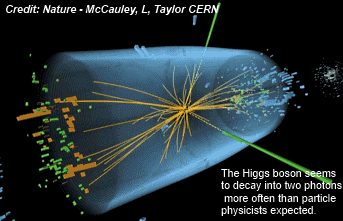|
News & Views item - July 2012 |
![]() Open Access, arXiv and the Higgs Particle. (July 20, 2012)
Open Access, arXiv and the Higgs Particle. (July 20, 2012)
With the announcement that a newly discovered subatomic particle at CERN fits the description of the Higgs Boson with a mass of at about 125 gigaelectronvolts (GeV), roughly 133 times the mass of a proton Geoff Brumfiel writes in Nature: "theoretical particle physicists, ...are revelling in the biggest glut of data they’ve had since the 1990s. Many are working evenings and weekends to interpret the results, and they have already generated a publication boom, with dozens of papers about the discovery appearing on the preprint server arXiv.org during the past two weeks".
Now mightn't a sidebar to this account note that progress by the theorists has next to no dependence on journal open access, gold or green, or even commercial paywalls -- but sans arXiv -- that's a different matter.
From Mr Brumfiel's report -- a small sample of what the theorists are chewing over:
"I was one of the people who pushed the idea of extra dimensions that we could
see in our lifetime," says Joe Lykken, a theoretical physicist at Fermilab in
Batavia, Illinois. "Now that we have data, I’m becoming much more conservative." Lykken has turned to the
possibility that an exotic 'impostor' particle is creating a phantom Higgs
signal inside the machine.
we have data, I’m becoming much more conservative." Lykken has turned to the
possibility that an exotic 'impostor' particle is creating a phantom Higgs
signal inside the machine.
Many of the recent arXiv papers focus on the slivers of hope for SUperSYmmetry that are buried in the new data.
...the mass of the Higgs particle is too large to be explained by the simplest, or ‘minimal’, supersymmetry [SUSY] models. So some theorists are moving on to greener pastures outside the LHC’s confounding reach... It will take years’ more data to test some of the most promising ideas, says Gordon Kane, a theorist at the University of Michigan, Ann Arbor, and a longtime SUSY champion.
Frank Wilczek, a physicist at the Massachusetts Institute of Technology regarding SUSY says: "The last man standing, as far as ambitious ideas beyond the standard model go, is supersymmetry."
And Tomer Volansky, a theorist at Tel Aviv University: "If you’re the optimistic type, you could look to these small deviations and hope they can grow. Right now I want to listen to the data rather than thinking about theories."